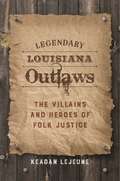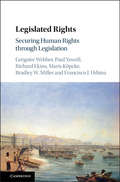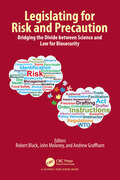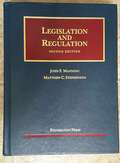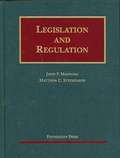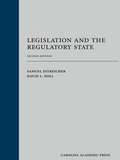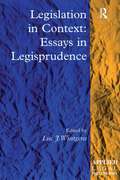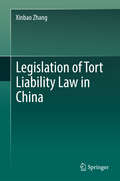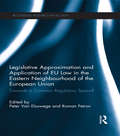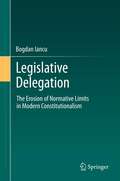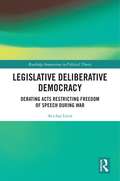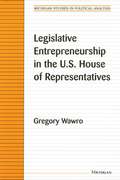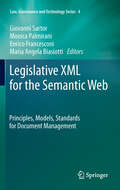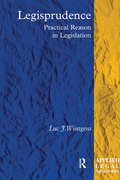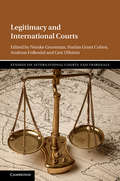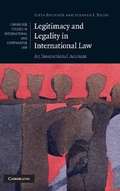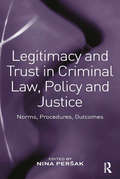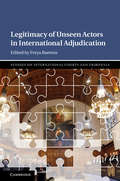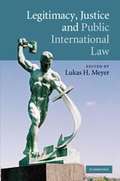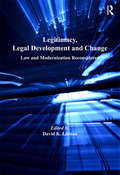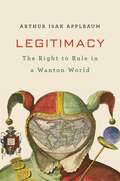- Table View
- List View
Legendary Louisiana Outlaws: The Villains and Heroes of Folk Justice
by Keagan LejeuneFrom the infamous pirate Jean Laffite and the storied couple Bonnie and Clyde, to less familiar bandits like train-robber Eugene Bunch and suspected murderer Leather Britches Smith, Legendary Louisiana Outlaws explores Louisiana's most fascinating fugitives. In this entertaining volume, Keagan LeJeune draws from historical accounts and current folklore to examine the specific moments and legal climate that spawned these memorable characters. He shows how Laffite embodied Louisiana's shift from an entrenched French and Spanish legal system to an American one, and relates how the notorious groups like the West and Kimbrell Clan served as community leaders and law officers but covertly preyed on Louisiana's Neutral Strip residents until citizens took the law into their own hands. Likewise, the bootlegging Dunn brothers in Vinton, he explains, demonstrate folk justice's distinction between an acceptable criminal act (operating an illegal moonshine still) and an unacceptable one (cold-blooded murder). Recounting each outlaw's life, LeJeune also considers their motives for breaking the law as well as their attempts at evading capture. Running from authorities and trying to escape imprisonment or even death, these men and women often relied on the support of ordinary citizens, sympathetic in the face of oppressive and unfair laws. Through the lens of folk life, LeJeune's engaging narrative demonstrates how a justice system functions and changes and highlights Louisiana's particular challenges in adapting a system of law and order to work for everyone.
Legends of the Security Services Industry: Profiles in Leadership
by Keith Oringer Michael HymansonThe global contract security market now totals over $200 billion, with the number of private security officers exceeding that of public law enforcement officers. But this wasn’t always the case.Legends of the Security Services Industry: Profiles in Leadership presents the unique stories of 15 industry legends, who transformed the industry from early private detective and small night watch companies into large-scale contract security companies. The large-scale companies include, but are not limited to, Pinkerton, Burns International, The Wackenhut Corporation, Guardsmark, Wells Fargo, and U.S. Security Associates; as well as today’s leading security companies, Allied Universal, Securitas, G4S, Prosegur, and GardaWorld.The book begins in the nineteenth century, with early U.S. legendary detectives: Allan Pinkerton and William Burns. Then, the book focuses largely from the mid-twentieth century to the present, where successive generations of legends built large-scale contract security companies which competed with, and then acquired, those formed by the early legends. Part II legends George Wackenhut, Ira Lipman, and Tom Wathen; Part III legends, Charles Schneider, Kenneth W. Oringer, William Whitmore, Jr., and Albert Berger; and Part IV, Scandinavian legends Jørgen Philip-Sørensen, Lars Nørby Johansen, and Thomas Berglund, all developed major security companies. Part V includes current global security leaders Helena Revoredo Gut, Stephan Crétier, and Steve Jones. Part VI reviews the timelines and successful leadership of these legendary leaders, with a look at the future of the industry.The legends’ personal stories contain colorful insight into how they capitalized on the industry’s explosive growth. While each generation of legends faced unique social and competitive landscapes, their personal stories illustrate how they respectively succeeded. Their leadership and management prowess enabled them to achieve great success, as they displayed vision and achieved their goals through grit, determination, hard work, charisma, organizational skills, and calculated risk-taking.Each chapter has been extensively researched and includes firsthand accounts based on interviews with living legends, colleagues, and family of deceased legends. Personal, company and signature event photos add further color to the moving narrative. Their stories are not only highly interesting, but also provide a framework for current leaders, and the next generation of entrepreneurs, on how to build and lead large-scale security service companies. With a Foreword from Robert D. McCrie, PhD, longtime John Jay Professor and editor of the renowned industry publication The Security Letter.
Legislated Rights: Securing Human Rights through Legislation
by Grégoire Webber Bradley W. Miller Paul Yowell Richard Ekins Maris Köpcke Francisco J. UrbinaThe important aspects of human wellbeing outlined in human rights instruments and constitutional bills of rights can only be adequately secured as and when they are rendered the object of specific rights and corresponding duties. It is often assumed that the main responsibility for specifying the content of such genuine rights lies with courts. Legislated Rights: Securing Human Rights through Legislation argues against this assumption, by showing how legislatures can and should be at the centre of the practice of human rights. This jointly authored book explores how and why legislatures, being strategically placed within a system of positive law, can help realise human rights through modes of protection that courts cannot provide by way of judicial review.
Legislating for Risk and Precaution: Bridging the Divide between Science and Law for Biosecurity
by Robert Black John Moloney Andrew GraffhamThis book aims to demystify the law for scientists and instructing officials by exploring the science and legal concepts of risk and precaution for national legislation to facilitate safe trade in agricultural products (in compliance with international trade rules).The book is not meant to supplant the many authoritative titles on legislative drafting, but provide some practical exercises on instructions and drafting for this area of law. The book also includes some important factors in legal reform, such as the audience for and access to legislation. It, therefore, has the potential to be a valuable resource for coordinated training of instructors and drafters by helping to secure a robust two-way dialogue between them.
Legislating under the Charter: Parliament, Executive Power, and Rights
by Emmett Macfarlane Janet Hiebert Anna DrakeLegislating under the Charter explores how governments and Parliament justify limitations on rights when advancing laws that raise rights concerns or when responding to judicial decisions under the Canadian Charter of Rights and Freedoms. Through an analysis of legislation concerning criminal justice policy, the approval of new safe consumption sites, sex work, and medical assistance in dying, the book provides a detailed analysis of the extent and nature of parliamentary deliberation about rights, the extent to which government initiatives are properly scrutinized, and the broader institutional relationships under the Charter. The authors draw from a host of qualitative data, including research interviews and examination of judicial decisions, various bills under study, Hansard debates from the floor of the House of Commons, committee and Senate scrutiny of legislation, bureaucratic advice and Charter statements by the department of justice, and news media coverage. The book offers a set of concrete reform proposals to improve the transparency and accountability of executive and bureaucratic vetting processes, and to strengthen the role of Parliament in upholding constitutional values and holding the government to account. In doing so, Legislating under the Charter contributes to the broader comparative scholarship on models of judicial review, morality policy, policy change, and constitutionalism.
Legislation And Regulation (University Casebook Ser.)
by John F. Manning Matthew C. StephensonThe updated casebook, Manning and Stephenson's Legislation and Regulation, 2d, is designed for a first-year class on Legislation & Regulation, and provides a proven, ready-to-use set of materials for those interested in introducing such a class to their 1L curriculum. The book focuses on the tools and methods of interpreting legal texts, using Supreme Court and other appellate decisions as the primary texts, yet the note material gently introduces students to applicable insights from political science, history, economics, and philosophy. The book aims to familiarize students with tools and techniques that lawyers and judges use when crafting legal arguments in statutory or regulatory contexts, and to give students a sense of the larger questions of institutional design implicated by these interpretive questions.
Legislation and Regulation
by John F. Manning Matthew C. StephensonThis casebook is specifically designed for a first-year class on Legislation Regulation, and provides a proven, ready-to-use set of materials for schools or instructors interested in introducing such a class to their 1L curriculum.
Legislation and the Regulatory State
by Samuel Estreicher David L. NollEstreicher & Noll's Legislation and the Regulatory State provides an accessible, up-to-date introduction to the institutions and procedures of the modern regulatory state. Designed to emphasize regulatory policy and the practical aspects of administrative lawyering, the casebook explores Congress's reasons for regulating and the choices it makes when enacting legislation, the legislative process and tools of statutory interpretation, administrative agencies' position within the Constitution's system of separated powers, the Administrative Procedure Act, and judicial review of agency action.
Legislation in Context: Essays In Legisprudence (Applied Legal Philosophy)
by Luc J. Wintgens Philippe ThionThe essays in this volume set out to provide a rational framework for legislation. Whilst legislation and regulation is the result of a political process, this volume considers whether they can also be the object of theoretical study. It examines the problems that are common to most European legal systems by applying the tools of legal theory to legislative problems ('legisprudence'). While traditional legal theory deals predominantly with the question of the application of law by a judge, legisprudence enlarges the scope of study to include the creation of law by the legislator. The essays published in the volume develop a new range of insights into the relationship between legislative problems and legal theory in a way that will interest legal scholars throughout the world. Specifically the work will attract the attention of those involved with constitutional law, EU law, human rights law and legal theory.
Legislation of Tort Liability Law in China
by Xinbao ZhangThis book studies the fundamental conflicts between the protections on the legal rights and interests of victims and the freedom of infringers to act first. It is divided into four parts, the first of which explores the relevant legal methodology in order to provide possible solutions to difficult problems in Chinese tort liability law. Secondly, it puts forward a range of suggestions on how to resolve key issues in China's torts liability law, including the general provisions; the provisions concerning the fault principle; the provisions of the non-fault principle; the special liability relation; damages; and defenses and related issues. Thirdly, the book addresses major institutional issues, including: the theory of consensus force; joint infringements; and operators' duty of care; as well as several key relations: between the right to claim insurance compensation and the right to claim compensation for personal injury; between the right to claim tort liability and the right to exercise property rights; and between the right to claim tort liability and the right to reject unjust enrichment. Further aspects in this section include compensation for death; mental damages; pure economic loss and compensation; punitive compensation; and compensation for road traffic accidents. Lastly, the book explores special issues in tort liability law, e. g. the infringement of media rights, and the specific tort liability in various administrative laws and regulations.
Legislative Approximation and Application of EU Law in the Eastern Neighbourhood of the European Union: Towards a Common Regulatory Space? (Routledge Research in EU Law)
by Peter Van Elsuwege and Roman PetrovThis book explores the exportation and application of European Union legislation beyond EU borders. It clarifies the means and instruments of the voluntary application of the EU’s norms by third countries and analyses in detail the process of legislative approximation between the EU and its East European neighbours. It also assesses the extent to which the EU is successful in promoting its legal standards abroad. The first part of the book addresses the EU’s mechanisms and instruments promoting the export of its own laws and practices to other countries. Key issues include the post-Lisbon constitutional basis for the EU’s engagement with its Eastern neighbours (Art. 8 TEU); the different methods of acquis export and the impact of a new generation of Association Agreements providing for the establishment of Deep and Comprehensive Free Trade Areas (DCFTAs) and, ultimately, a Neighbourhood Economic Community (NEC) between the EU and its Eastern partners. The second part of the book includes substantive country reports that analyse the process of legislative approximation and application of EU law in the Eastern Partnership countries and Russia, authored by leading academics from the countries concerned. While currently these countries are not working towards full EU membership, the EU encourages them to approximate and converge their legislation with the EU acquis. The book also offers a unique picture of current practice of the application of EU law by judiciaries in the countries of the Eastern Partnership and Russia. The book concludes with reflections on the multi-faceted character of legislative approximation and the challenges surrounding the application of EU law in the EU’s Eastern neighbourhood. The conclusions reached are highly informative as to the effectiveness of present and future EU external regional policies aimed at the promotion of EU common values and EU legislation into the legal orders of third countries.
Legislative Delegation
by Bogdan IancuAn overarching question of contemporary constitutionalism is whether equilibriums devised prior to the emergence of the modern administrative-industrial state can be preserved or recreated by means of fundamental law. The book approaches this problem indirectly, through the conceptual lens offered by constitutional developments relating to the adoption of normative limitations on the delegation of law-making authority. Three analytical strands (constitutional theory, constitutional history, and contemporary constitutional and administrative law) run through the argument. They merge into a broader account of the conceptual ramifications, the phenomenon, and the constitutional treatment of delegation in a number of paradigmatic legal systems. As it is argued, the development and failure of constitutional rules imposing limits on legislative delegation reveal the conditions for the possibility of classical limited government and, conversely, the erosion of normativity in contemporary constitutionalism.
Legislative Deliberative Democracy: Debating Acts Restricting Freedom of Speech during War (Routledge Innovations in Political Theory)
by Avichai LevitFreedom of speech is a basic right in a democracy. During war however, national legislatures tend to enact laws that restrict this basic right. Under what circumstances can such laws be democratically legitimate? Avichai Levit argues that the degree of democratic legitimacy of laws that restrict freedom of speech during war, depends on the extent of legislature deliberation on such laws. The more law makers in both chambers of the legislature, seriously consider information and arguments, reason on the common good, and seek to persuade and decide the best legislative outcome, in committees and on the floor, the more democratic legitimacy can be associated with such laws. This book fills a gap in the scholarly literature regarding the evaluation of the democratic legitimacy of laws restricting freedom of speech during war, by bridging different theoretical perceptions and presenting an alternative normative account of deliberative democracy which focuses on the deliberations of a national legislature. Using the United States as a case study, this book goes into the details of Congressional deliberation during World War I, World War II and the Cold War, as well as the political histories that brought about such laws. Legislative Deliberative Democracy will be of interest to academics and students alike in the fields of American Constitutional law, Political theory, American politics and political history.
Legislative Entrepreneurship in the U.S. House of Representatives
by Gregory WawroWhen members are elected to the House of Representatives they have a certain freedom to decide how they will act as members and how they will build their reputations. Just as in the market place entrepreneurs build businesses, so in the House of Representatives members have the freedom to choose to build legislative programs that will enhance their reputations in the institution. And yet entrepreneurship is also costly to members. Gregory Wawro explains why members of the House engage in legislative entrepreneurship by examining what motivates them to acquire policy knowledge, draft legislation, build coalitions, and push their legislation in the House. He considers what incentives members have to perform what many have perceived to be the difficult and unrewarding tasks of legislating. This book shows how becoming a legislative entrepreneur relates to members' goals of reelection, enacting good public policy, and obtaining influence in the House. The analysis differs from previous studies of this behavior, which for the most part have employed case study methods and have relied on anecdotal evidence to support their arguments. Wawro analyzes legislative entrepreneurship in a general and systematic fashion, developing hypotheses from rational-choice-based theories and testing these hypotheses using quantitative methods. Wawro argues that members engage in legislative entrepreneurship in order to get ahead within the House. He finds that the more legislative entrepreneurship that members engage in, the more likely it is that they will advance to prestigious positions. This book is of interest to students of Congress, legislative behavior and institutions, elections, and campaign finance. Gregory Wawro is Assistant Professor of Political Science, Columbia University.
Legislative Reference Services and Sources
by Peter Gellatly Kathleen LowHere is the first introductory guide to all aspects of providing legislative reference services. Unlike special libraries which deal with one specific discipline, legislative reference bureaus must deal with a full spectrum of subject areas and meet the unique needs of elected and appointed officials and their staffs. This guide helps librarians find the best current resources and services to answer the varied demands for information typical of legislative reference libraries. Legislative Reference Services and Sources facilitates the work of legislative librarians and makes them confident so that they can supply legislators and their staffs with the information needed to effectively examine, draft, or enact legislation of benefit to the public.No other book on the market provides such a comprehensive overview of legislative reference services. Author Kathleen Low acquaints librarians with over 100 sources useful in responding to information requests from legislators. A wide range of valuable topics are covered that will help legislative reference librarians meet the information demands of legislators and lawmakers including: an overview of essential reference services needed by legislators and their staffs specific protocols and forms of etiquette to observe when promoting services to elected and appointed officials over 100 frequently consulted titles in legislative references the usefulness of online resources how to recognize special services and sensitivity warranted by patrons and the services and responses to expect in returnLegislative Reference Services and Sources addresses the legislative reference services commonly provided, promotion of services, the librarian/client relationship, client expectations, the ethics of responding to certain requests, and the core resources used in legislative reference requests. It is an invaluable tool for beginning level legislative librarians, public services librarians, and state and federal agency librarians who need an introduction to this unique type of information service.
Legislative XML for the Semantic Web
by Giovanni Sartor Maria Angela Biasiotti Monica Palmirani Enrico FrancesconiThis volume examines the basic layers of the standard-based creation and usage of legislation. In particular, it addresses the identification of legislative documents, their structure, the basic metadata and legislative changes. Since mature technologies and established practices are already in place for these layers, a standard-based approach is a necessary aspect of the up-to-date management of legislative resources. Starting out with an overview of the context for the use of XML standards in legislation, the book next examines the rationale of standard-based management of legislative documents. It goes on to address such issues as naming, the Akoma-Ntoso document model, the contribution of standard-based document management to handling legislative dynamics, meta-standards and interchange standards. The volume concludes with a discussion of semantic resources and a review on systems and projects.
Legislator Success in Fragmented Congresses in Argentina
by Ernesto Calvo"Plurality-led Congresses are among the most pervasive and least studied phenomena in presidential systems around the world. Often conflated with divided government, where an organized opposition controls a majority of seats in congress, plurality-led congresses are characterized by a party with fewer than 50 percent of the seats still in control of the legislative gates. Extensive gatekeeping authority without plenary majorities, this book shows, leads to policy outcomes that are substantially different from those observed in majority-led congresses. Through detailed analyses of legislative success in Argentina and Uruguay, this book explores the determinants of law enactment in fragmented congresses. It describes in detail how the lack of majority support explains legislative success in standing committees, the chamber directorate, and the plenary floor"--
Legisprudence: Practical Reason in Legislation (Applied Legal Philosophy)
by Luc J. WintgensThis book establishes legisprudence, in contrast to jurisprudence, as a legal theory of rational law-making. It suggests that by rejecting the common wisdom about the nature of political law-making, legislation could be improved and streamlined. Using the methods, theoretical insights and tools of current legal theory and philosophy of law in a new way, the book suggests the creation of law by legislators rather than government. Raising new questions and problems of the validity of norms, the book opens a new perspective on legitimacy of norms, their meaning and the structure of the legal system. In distinguishing legitimacy and legitimation of law, the book ventures into the philosophical roots of legal theory and suggests the articulation of a new conception of sovereignty. In shifting the emphasis to the position of the legislator and legislation, this book opens a number of new insights into the relationship between legislative problems and legal theory. Its main claim is that legislation should be justified by the legislator.
Legitimacy and International Courts (Studies on International Courts and Tribunals)
by Geir Ulfstein Andreas Follesdal Nienke Grossman Harlan Grant CohenOne of the most noted developments in international law over the past twenty years is the proliferation of international courts and tribunals. They decide who has the right to exploit natural resources, define the scope of human rights, delimit international boundaries and determine when the use of force is prohibited. As the number and influence of international courts grow, so too do challenges to their legitimacy. This volume provides new interdisciplinary insights into international courts' legitimacy: what drives and undermines the legitimacy of these bodies? How do drivers change depending on the court concerned? What is the link between legitimacy, democracy, effectiveness and justice? Top international experts analyse legitimacy for specific international courts, as well as the links between legitimacy and cross-cutting themes. Failure to understand and respond to legitimacy concerns can endanger both the courts and the law they interpret and apply.
Legitimacy and Legality in International Law
by Jutta Brunnée Stephen J. ToopeIt has never been more important to understand how international law enables and constrains international politics. By drawing together the legal theory of Lon Fuller and the insights of constructivist international relations scholars, this book articulates a pragmatic view of how international obligation is created and maintained. First, legal norms can only arise in the context of social norms based on shared understandings. Second, internal features of law, or 'criteria of legality', are crucial to law's ability to promote adherence, to inspire 'fidelity'. Third, legal norms are built, maintained or destroyed through a continuing practice of legality. Through case studies of the climate-change regime, the anti-torture norm, and the prohibition on the use of force, it is shown that these three elements produce a distinctive legal legitimacy and a sense of commitment among those to whom law is addressed.
Legitimacy and Trust in Criminal Law, Policy and Justice: Norms, Procedures, Outcomes
by Nina PeršakWhereas previous studies of legitimacy and trust have mostly dealt with procedural justice and the police, this book focuses on other crucial understudied aspects of legitimacy within criminal law, policy and criminal justice. The chapters expand and develop current criminological, legal and socio-legal research by addressing conceptions of legitimacy linked to criminal law norms, criminalisation and sanctioning; by examining EU legal and policy aspects of the phenomenon; and by exploring some specific court-related issues of legitimacy and trust, hitherto neglected. With contributions from across the EU, this interdisciplinary collection presents a valuable discussion on the importance of trust in legal institutions of modern democracies and suggests ideas for future research in this area to challenge ways of thinking about legitimacy.
Legitimacy of Unseen Actors in International Adjudication (Studies on International Courts and Tribunals)
by Freya BaetensInternational courts and tribunals differ in their institutional composition and functions, but a shared characteristic is their reliance on the contribution of individuals other than the judicial decision-makers themselves. Such 'unseen actors' may take the form of registrars and legal officers, but also non-lawyers such as translators and scientific experts. Unseen actors are vital to the functioning of international adjudication, exerting varying levels of influence on judicial processes and outcomes. The opaqueness of their roles, combined with the significance of judicial decisions for the parties involved as well as a wider range of stakeholders, raises questions about unseen actors' impact on the legitimacy of international dispute settlement. This book aims to answer such legitimacy questions and identify 'best practices' through a multifaceted enquiry into common connections and patterns in the institutional composition and daily practice of international courts and tribunals.
Legitimacy, Justice and Public International Law
by Lukas H. MeyerDo states or individuals stand under duties of international justice to people who live elsewhere and to other states? How are we to assess the legitimacy of international institutions such as the International Monetary Fund and the United Nations Security Council? Should we support reforms of international institutions and how should we go about assessing alternative proposals of such reforms? The book brings together leading scholars of public international law, jurisprudence and international relations, political philosophers and political theorists to explore the central notions of international legitimacy and global justice. The essays examine how these notions are related and how understanding the relationships will help us comparatively assess the validity of proposals for the reform of international institutions and public international law.
Legitimacy, Legal Development and Change: Law and Modernization Reconsidered
by David K. LinnanThis book addresses critical questions about how legal development works in practice. Can law be employed to shape behavior as a form of social engineering, or must social behavior change first, relegating legal change to follow as ratification or reinforcement? And what is legal development's source of legitimacy if not modernization? But by the same token, whose version of modernization will predominate absent a Western monopoly on change? There are now legal development alternatives, especially from Asia, so we need a better way to ask the right questions of different approaches primarily in (non-Western) Asia, Africa, the Islamic world, plus South America. Incoming waves of change like the 'Arab spring' lie on the horizon. Meanwhile, debates are sharpening about law's role in economic development versus democracy and governance under the rubric of the rule of law. More than a general survey of law and modernization theory and practice, this work is a timely reference for practitioners of institutional reform, and a thought-provoking interdisciplinary collection of essays in an area of renewed practical and scholarly interest. The contributors are a distinguished international group of scholars and practitioners of law, development, social sciences, and religion with extensive experience in the developing world.
Legitimacy: The Right to Govern in a Wanton World
by Arthur Isak ApplbaumWhat makes a government legitimate? Arthur Isak Applbaum rigorously argues that the greatest threat to democracies today is not loss of basic rights or despotism. It is the tyranny of unreason: domination of citizens by incoherent, inconstant, incontinent rulers. A government that cannot govern itself cannot legitimately govern others.
